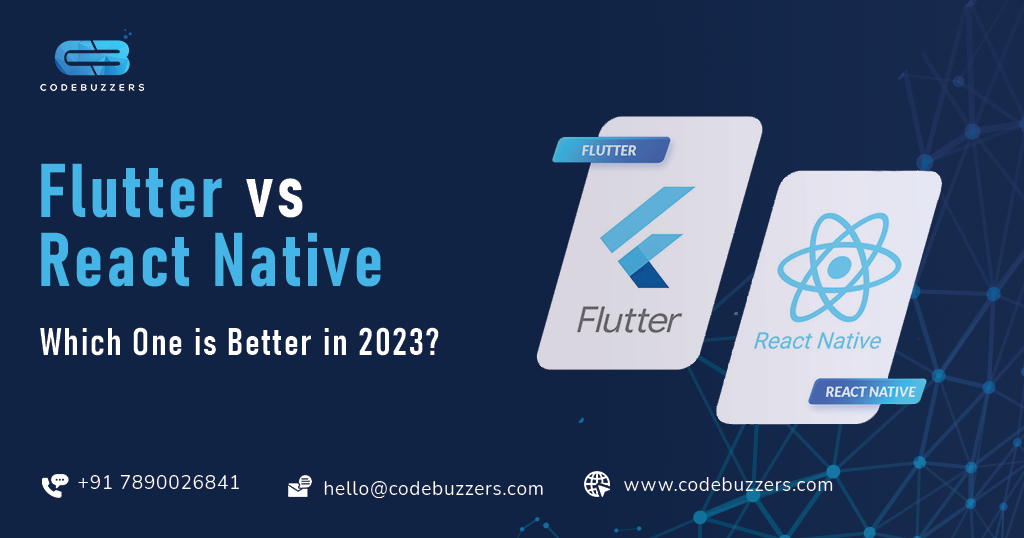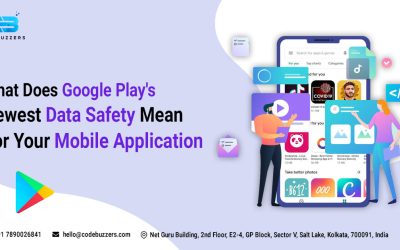Flutter vs. React Native: Which One is Better in 2023?
Every company wishes to have an app available on both the App Store and Google Play. However, before releasing a mobile application to the market, you must select a technological stack. Will it be React Native or Flutter? Do you know which is worthwhile in terms of money, time, and effort?
In conclusion, Flutter is a good choice if your budget is minimal or you need to create a small application rapidly. You may also make a Flutter application if your project’s user interface is essential. However, if your budget is ample and you want to construct a complex program, React Native is the way to go. Continue reading about the two app development frameworks and their key differences.
What is Flutter?
Google’s Flutter is a cross-platform mobile app development framework. It enables developers to create and deliver aesthetically appealing, natively generated applications for mobile (iOS, Android), web, and desktop platforms utilizing a single code base. You may compile Flutter source code to a native Windows, MacOS, or Linux desktop program when designing desktop apps with Flutter.
Flutter’s desktop support extends to plugins; developers may use existing plugins that support MacOS, Windows, or Linux or create their own. Flutter’s desktop support is currently in beta. It contains feature gaps. Developers can sample a beta snapshot of desktop support on the stable channel or stay up with the newest desktop updates on the beta channel.
Flutter’s browser support provides the same experiences as on mobile. In addition, it implies that you can now create Android, iOS, and web apps using the same codebase.
The web support in Flutter is beneficial in the following scenarios:
- The Flutter platform enables the creation of high-quality Progressive Web Apps (PWA), which can be installed, supported offline, and customized based on the users’ preferences.
- Single Page Applications (SPA) load once and transport data to and from internet services.
- Web support for Flutter provides a browser-based delivery option for current Flutter mobile applications.
The first thing to highlight in Flutter is the developer’s agility. Constructing the interactive features while creating software can be considerably easy when a widget system is provided for development. As a result, the final product may be more agile and high-quality on Android and iOS versions, as intended. Furthermore, the “hot reload” feature makes it simple to see the changes made to the code, offering fast feedback to the developer and enhancing productivity. Hot reload lets you see changes in the code immediately reflected on the UI. This expedites working on the application’s appearance and allows developers to repair faults, saving money and time.
What is React Native?
React Native is a prominent open-source mobile application development framework built by Facebook that was first released in 2015. It makes cross-platform mobile applications with real native capabilities using JavaScript. This means you can create natively rendered mobile apps for iOS and Android with a single codebase. Because of this feature, React Native has become one of the business’s most popular app development frameworks. According to the Stack Overflow Survey 2021, 58.08% of developers favored working with React Native in the previous year and would do so again in the future.
React Native is built mostly on JavaScript, a web development technology. As a result, JavaScript developers may simply create mobile apps with React Native. This saves time and eliminates the need for developers to master complicated programming languages like Objective-C and Java to create an app.
Furthermore, because JavaScript components are based on iOS and Android components, developers do not need to recreate the same software for another platform. Overall, the React Native mobile app development framework is a win-win situation for businesses in terms of saving time, effort, and money.
Advantages of Flutter Technology
1. Use a single codebase for all platforms.
Gone are when you had to create code for Android and another for iOS devices. By reusing code in Flutter, you can develop the same code base for mobile Android and iOS, as well as web, desktop, and other platforms. This greatly reduces development time, eliminates costs, and allows you to deploy your product much faster.
2. The “It’s all Widgets” approach opens up a world of possibilities.
Flutter’s custom widgets are an incredible treat when designing beautiful aesthetics for your app. At the same time, you don’t have to be concerned about the user interface on different devices.
3. Extensive library
Flutter uses the Skia Graphics Package, an open-source graphics library that is both fast and mature. Every time a view changes, the UI is redrawn. The result? The software loads quickly and smoothly.
4. Quick testing with hot reloading
The hot reload functionality speeds up app development. There is no need to restart the app to view every change you make in the code using Flutter. You may simply make changes in real-time to your app, giving you additional opportunities to experiment with the code and correct errors on the fly.
Disadvantages of Flutter Technology
1. Large file size due to widgets
To begin with, Flutter apps are fairly big and “heavy.” They take up a lot of storage space and take a long time to download or update.
2. Complicated update
Updating Flutter modules is required when operating system programming requirements change. Because the modules are permanent parts of the application, they must also be recompiled and reloaded on the devices.
3. Limited tool and library set
Because Flutter is a relatively new programming framework, you may not be able to find the needed functionalities in the existing library. The Flutter will need time to develop tools, improve functionality, and grow the community.
Advantages of React Native Technology
1. Less expensive than indigenous development
You need to develop an application in JavaScript once when utilizing React Native. Following a native method, on the other hand, necessitates creating two applications from scratch for iOS and Android. Because React Native requires only one line of code, you avoid needing two development teams and save twice as much money on construction and maintenance.
2. Hastens development and shortens time to market
One of React Native’s most intriguing features is its quick development time. Accelerate the process by utilizing the framework’s various prepared components. Compared to developing the same app for Android and iOS, developers can save up to 40% by using React Native.
3. Mobile
App developers do not have to start over if they choose or need to transfer the app to another development framework in the future. They may export the program from React Native and import it into Android Studio or Xcode, where they can continue working. This is a significant advantage of React Native for mobile app development, increasing its versatility.
4. View Changes Immediately
The “live reloading” or “hot reloading” feature of React Native allows developers to simultaneously preview their changes as they work. Because of the real-time input, this gives developers a significant edge.
Disadvantages of React Native Technology
1. Limited Accessibility
Because React Native does not have full access to all native device APIs, the app’s functionality may be limited.
2. Restricted Support
Because React Native is a free source with limited support. This might make it harder for developers to seek assistance when they become stuck.
3. Inadequate Documentation
React Native’s documentation is limited, making it tough for developers to find solutions to their problems.
4. Limited Third-Party Libraries
Because the number of third-party libraries available for React Native is limited, developers may struggle to locate the tools they require.
5. Learning Curve
The high learning curve of React Native might make it tough for developers.
Flutter vs. React Native
Programming Language
React Native is developed entirely in JavaScript and uses React. This is advantageous for React Native because JavaScript is one of the most widely used languages in the world today. Flitter is written in the Dart programming language. Dart is a programming language developed by Google in 2011 that developers rarely use.
Installation
The setup of React Native is straightforward. React-Native CLI is installed globally through the command line. Remember that you will also require NodeJS and Yarn as package managers. Flutter may be installed by downloading the binaries for a certain mobile platform. The following step is to include it in your PATH variable. Fortunately, you can accomplish this using the command line. However, with this new parameter, Flutter loses points versus React Native. Its setup isn’t as simple as it appears.
Architecture
React Native uses the JavaScript bridge to communicate between JavaScript and the native language. Here’s how it works: JSON messages are sent between the parties. Because the message is asynchronous, the app’s UI should be fluid. However, because the bridge affects rendering performance, there is a possibility of a sluggish UI at the end. On the other hand, Flutter does not require a bridge to connect with native components. It contains everything, including frameworks such as Cupertino and Material Design. Because of this Flutter advantage, applications on diverse platforms are more reliable and predictable than React Native apps.
Development Time
React Native features a high degree of code reusability across platforms. Furthermore, the developer community has built many libraries that use as building blocks to accelerate development. Furthermore, React Native offers a hot reload capability that allows you to observe changes in your app without recompiling it.
What do you think? Flutter also offers a hot reload functionality, which allows you to quickly iterate and receive feedback. Flutter also provides quick app compilation.
Code Reuse
Regarding code reusability, Flutter has a more flexible codebase than React Native. Modifying a single line of code, developing new logic, and reusing your codebase are all possible with Flutter.
Conclusion
Flutter is attracting an increasing number of businesses. After all, as Google refines its tool, we see regular advancements in the Flutter SDK. Furthermore, the community is usually kind and passionate. Furthermore, Flutter allows us to develop mobile apps and web and desktop apps (Flutter’s desktop support is available as a beta release on the stable channel). Putting it all together – and given that prominent organizations like Alibaba are already utilizing Flutter – the toolkit’s future appears bright. React Native, on the other hand, is now undergoing a large-scale re-architecture within Facebook. Codebuzzers is a leading mobile app development company in today’s digital world, producing the most inventive products.




